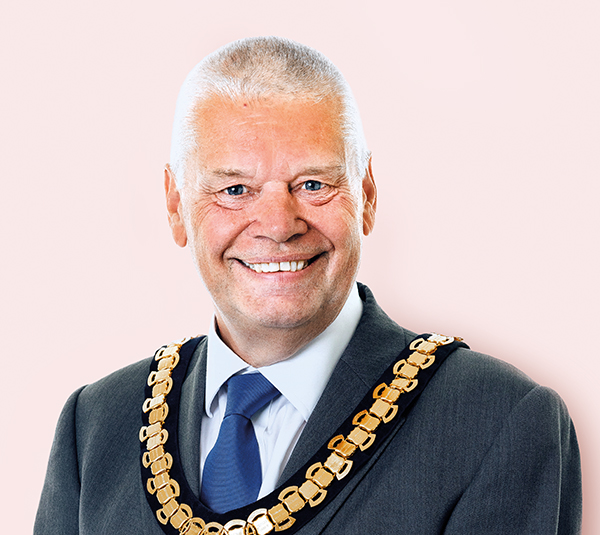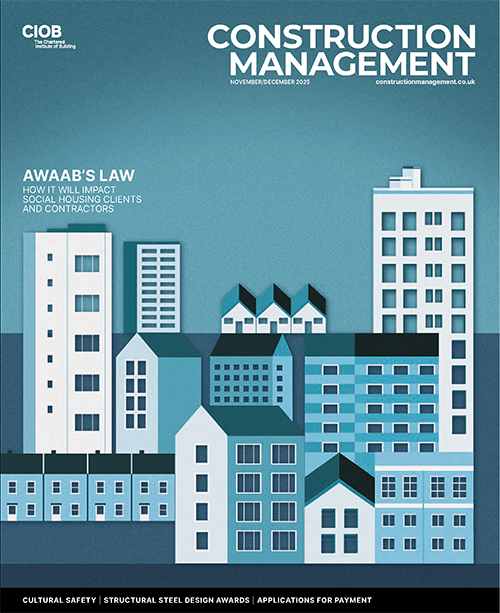
Construction contributes so much to society – but the industry needs to get its house in order on competency, says new CIOB president Paul Gandy. Will Mann speaks to him.
Paul Gandy is passionate about social value. “It’s a visible and tangible way for the industry to show the good it does,” says the new CIOB president.
“Construction enables all major government objectives – transport, levelling up, clean water, green energy, healthcare. None of it happens without us. We don’t celebrate that enough.”
Social value will be one of the major themes of Gandy’s presidency, which starts this month, along with sustainability, and one of construction’s most pressing issues – competency, where his company Tilbury Douglas has already taken a lead.
CV: Paul Gandy FCIOB
Tilbury Douglas: Board adviser (part-time), 2024 to present; CEO 2019-24
Kier: Director, Kier Major Projects 2018-19; director, Kier Building, 2016-18
Balfour Beatty: Managing director London, 2014-16
Lendlease: Operations director – Elephant and Castle redevelopment, 2013-14; director of operations, 2012-13; executive general manager, England and Wales, 2008-12
Carillion: Managing director, Carillion Direct Sourcing, 2007-08; operations director – defence, 2007-08
Multiplex: Managing director UK, 2000-05
Kvaerner Construction: Director, UK PFI construction, 1997-2000
Education
University of Westminster: BSc Building, 1978-82
Management Centre Buckingham: MBA Property and Construction Business Management, 1988-92
Few CIOB presidents can have boasted the depth of experience at construction’s sharp end that Gandy has.
His CV looks like a who’s who of the biggest names in contracting, including Balfour Beatty, Kier, Lendlease and Multiplex, working on high-profile projects including Wembley Stadium and the Elephant & Castle regeneration. He stepped down last November as CEO of Tilbury Douglas but remains with the contractor as a board adviser.
Social value
His career dates back more than four decades, a period of huge change in construction, though he reasons that “big contractors have always done social value in some form – working with schools, employing locally – but it wasn’t the norm, and we didn’t talk about it”.
“What’s changed in the last decade is visibility, vocabulary and measurement,” he says. “Government initiatives like the Construction Playbook have moved the dial. Public procurement now recognises value, not just cost.”
Because social value is not just about the built product; it’s about people, Gandy continues.
“Creating jobs. Particularly for people who face social barriers. Getting into schools. People can’t aspire to work in construction if they don’t understand it.
“We need to keep building on apprenticeships. It’s fantastic that they’re growing again after being devalued 30 years ago. Today, we’re getting top talent through apprenticeships, whether in trades, management or digital.
“That’s all part of the social value we can deliver. It shows the best face of construction.”
On sustainability, Gandy feels construction has a “challenge”. “We’re not unwilling to be sustainable; it’s just that our materials, like concrete and steel, are inherently carbon-intensive. It’s going to be a long and difficult journey.”
‘We need to stop knocking buildings down’
That is why, Gandy says bluntly, “We need to stop knocking buildings down. Over half the carbon is embedded in foundations and frames. The carbon savings are enormous. No new material we can develop will save as much carbon as simply not demolishing a building.
“I’ve said this before, to people in government, and I’ll say it again, more loudly. Refurbishment might involve compromises – it may not deliver a perfect building, but it delivers a more sustainable one.
“New buildings we construct now are much more environmentally friendly, less carbon-intensive to run compared to 15 to 20 years ago. But we need to think about our existing building stock. We need to renovate, retrofit, repurpose.”
Gandy acknowledges that refurbishment projects are more technically complicated than new builds, which leads us to another of his key presidential themes: competence.
“The good news is that it’s now part of the industry’s vocabulary,” he says. “Ten years ago, we weren’t talking about competence at all – not at an industry level. Now we are, and that’s progress. It’s a shame we needed a push, but let’s use that to do things better.
Competence is taken seriously
“It may seem obvious – you wouldn’t want incompetence on a project – but the reality is, we’ve seen it happen. So it’s good that competence is now taken seriously.
“But we have to remember, it’s not just about training and qualifications. Competence is a combination of training, experience and behaviour. You can have the education, but that’s no use if your behaviour isn’t right.
“So, I encourage people to look in the mirror: What’s changed in the industry? What are my own gaps? And then do something about it.
“That’s what CPD should really be about. It’s not just ticking a box or attending a course.
“It’s thinking: “What do I need to be better at? Where do I need to grow?”
Tilbury Douglas was the first contractor to put project managers through CIOB’s Principal Contractor Competency Certification Scheme (PCCCS) last year.

“Refurbishment might not deliver a perfect building, but it delivers a more sustainable one. I’ve said this to government before, and I’ll say it again, more loudly.”
“It was about being an exemplar – externally and internally,” says Gandy. “Externally we wanted to show we take this seriously, and internally it motivated people to want to take the certification.
“But mostly, we wanted to draw attention to the kind of competencies we now need in the industry, especially on complex, high-risk projects, and what a great scheme this is CIOB has introduced.
“It’s a tough, tough gig – that’s the feedback we’ve had from our project managers who have been through the scheme. And that’s good. It means the bar is high.”
Even local builders wear PPE now
Take up for CIOB’s PCCCS continues to grow, so does Gandy feel this is an indicator that industry attitudes are shifting on competency?
“I do,” he replies. “Among tier 1 contractors and informed supply chain partners, we’ve definitely moved forward.
“It’s easy to be cynical and say it’s only the big players, but we said the same about health and safety 30 years ago. Now, even local builders wear PPE. That change took time, but it happened. And it’s our job – as leaders – to raise the bar and then exceed it.”
While health and safety has been transformed during Gandy’s construction career, he’s not convinced the industry has taken many other leaps forward.
“We’re not seeing massive technical changes,” he says. “Compared to the car industry, where the product is vastly better than 10 or 20 years ago, we’re not seeing that level of change. Sure, the odd clever innovation here and there, but no ‘silver bullet’ technologies.
“The issue for me is less what we build, more how we build it. During Covid-19, when we were working on essential projects under tight restrictions, construction got more efficient. My peers at other big contractors said the same.
“It was down to meticulous planning, clear sequencing, separation of trades. Nothing revolutionary – just good discipline. Some of those lessons have been forgotten, unfortunately.
“We often talk about modern methods of construction (MMC). But volumetric modular – particularly in residential – has struggled.
“Though I do think there’s potential for more efficiency through standardisation and componentisation. I still don’t understand why we lay so many bricks when good slip systems exist which are faster to install and meet the same thermal and fire performance standards.
“The barrier is often client preference. Designers like what they know. Customers like the traditional look.”
Standardised solutions
Gandy reflects on the PFI-driven custodial building programme of the 1990s, which he worked on with M&E firm Trafalgar House (part of Kvaerner, later bought by Skanska).
“Private finance was the catalyst for prison construction to became standardised and systemised – flat-packed in concrete – which transformed the speed of delivery and is still used today,” he says.
“The Department for Education is a great example too. Post Building Schools for the Future, they’ve driven contractors toward more standardised, repeatable solutions. Schools now, while they may look different, are often built from kits of parts. The results are reliable delivery and happy end users.
“There is a lot of good stuff this industry does, including social value,” smiles Gandy. “We just need to celebrate it more and talk about it more. Unfortunately, we’re a fragmented industry and we’ve not been very good at communicating that to the government. But I’ll be doing my bit.”
Comments
Comments are closed.












Excellent points with Paul Gandy showing leadership on this critical challenge in construction. The focus should be on quality all the time and to achieve quality we need to evaluate the level of competence for different types of work. We also need to have a less binary (& pejorative) way of looking at competence. It will take time, but we need to be heading on the right track now.
There’s nothing with taking a step back if the way forward isn’t working. You can’t manage the building process on a computer. Your managers need to be on site managing!
Quality levels need to be improved and that will only come well trained and qualified site staff. Paul is on the right track and makes well informed comments.